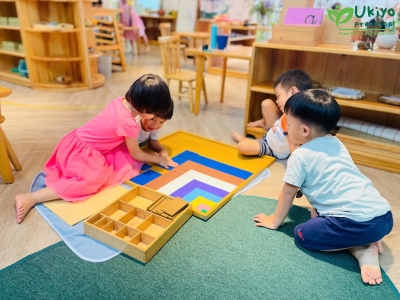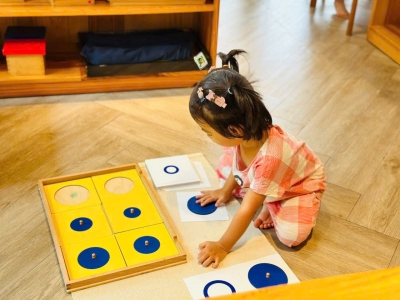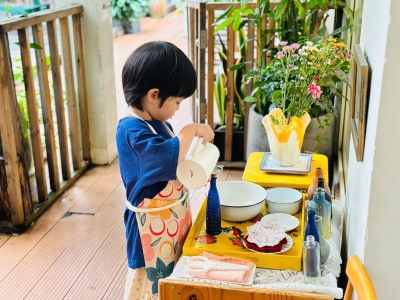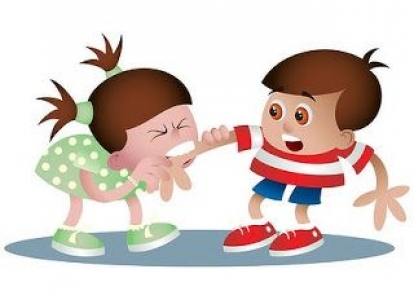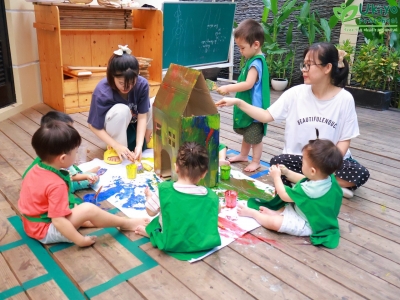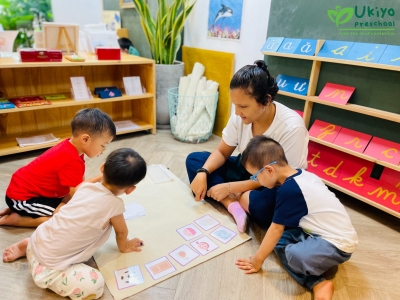DEVELOPING SELF-CONTROL FROM 12-24 MONTHS
Toddlers have minds of their own and strong feelings that they express with gusto. “No!” becomes a favorite word and a powerful way to assert their independence. At the same time, toddlers can become easily frustrated because there are still many things that they want to do but cannot. So this second year of life can be challenging for both parents and children, as toddlers have intense feelings that they are not yet able to control. Routines are especially helpful during this year since they make children feel secure at a time when they can often feel out of control.
Tune in to your child’s temperament.
Temperament describes the individual way that a person experiences and responds to the world around her. Some people are quite flexible and “go-with-the-flow”, others have a hard time with change. Some people are very outgoing, others prefer to hang back and observe before jumping into new situations. These ways of approaching the world are all part of our temperament. They are characteristics we are all born with. Temperament is not something any of us choose or that parents create.
A child’s temperament influences their ability to manage their feelings and to cope with stressors. Children who, by nature, are intense reactors, have a more negative overall mood, or who don’t respond well to change may have a harder time developing self-control. Their feelings and reactions are so big that controlling them is simply harder to do. They may need extra time and guidance from you to develop the coping skills they need to self-soothe and stay in control.
What You Can Do:
Look for patterns. Watch how your child responds in different situations to better understand his temperament. How does he handle changes and challenges? What kinds of people and situations does he enjoy or avoid? * Identifying patterns can help you begin to anticipate how your child will respond in certain situations. You can start to identify people, places, and experiences that may be challenging for him and help him prepare for how to handle them. You can also learn what comforts him and helps him cope in stressful situations.
Empathize with your child’s feelings. When your child is upset—perhaps a car has lost a wheel or her block tower has fallen down– let her know you understand how sad and disappointed she is. Don’t rush to cheer her up. It’ll be okay, We’ll fix it, or Let’s build it again may be valid responses. But the most important first step is to let her know it’s okay to feel what she’s feeling. You are so disappointed the tower fell. That is so frustrating. You worked so hard. Rub her back and soothe her. Then together you can figure out what to do. Letting her know you understand and accept her feelings—also known as empathy—helps her work through those difficult feelings and learn how to cope with them. Experiencing empathy also helps her show empathy to others, a very important factor in developing healthy relationships.
[This recommendation was adapted from Greenspan’s Building Healthy Minds: The Six Experiences That Create Intelligence and Emotional Growth in Babies and Young Children]
Think about your temperament.
Your temperament matters, too. How well a parent’s temperament matches their child’s temperament is known as “goodness of fit.” For example, a shy, quiet parent may have difficulty dealing with an active, feisty child. Or an outgoing parent may feel confused about how to handle her shy and fearful child. Taking a moment to think about your own temperament will help you be aware of the “fit” between you and your child. Keep in mind that even if you and your child are very different, you can still be a wonderful and nurturing parent. The key is being aware of the ways you are similar and different. This knowledge will help you understand your child’s individual needs and support his development.
For example, an outgoing parent may initially encourage her shy child to immediately join in a playgroup because that is her natural response and desire. However, when she keeps in mind that her child’s approach to new situations is quite different from hers, she can put her own feelings aside and provide the support her toddler needs. She may start by helping her child “warm up” by sitting on the edge of the playgroup, watching the other children and talking about what they are doing. She may then play with him one-on-one and after a few minutes, ask one other child to join in. Adapting her approach helps this parent support her child’s growing ability to cope with his feelings and develop self-control.
[This example is from Lerner and Dombro’s Bringing Up Baby: Three Steps to Making Good Decisions in Your Child’s First Years. To read more, visit our resource and referral list.]
What You Can Do:
Don’t just do something, stand there!
When you are in a stressful situation with your child, it’s important to stop for a moment and think about what’s happening. What is your child telling you about what he is feeling and what he may need to cope? What are you feeling and reacting to? This “waiting time”—even if only a few seconds long—gives you the chance to figure out what may be the best approach for our individual child.
Be a role model for coping with strong feelings and regaining control.
I just spilled the milk all over the floor! And we are late for story time at the library! I am feeling so mad right now. I think I am just going to close my eyes and count to five before I clean up. Through your words and actions, you can show your child how it is possible to manage and recover from a difficult situation.
Have appropriate expectations.
Young toddlers have difficulty controlling their feelings and behavior because they are not yet able to:
- Fully understand the consequences of their actions.
- Grasp the difference between acceptable and unacceptable behavior
- Have the long-term memory to consistently recall the limits or rules you set
- Have the impulse control to stop themselves from repeating an unacceptable behavior
- Consequently, punishment is not effective and can be scary and confusing for children.
What You Can Do:
Stop the behavior.
For example, take your child’s hand– firmly but not roughly– and tell him No hitting. Hitting hurts. in a serious, calm voice.
Validate your child’s feelings.
You are so angry that Paolo took your toy. It’s okay to feel angry. But you cannot hit. Hitting hurts. .. Model appropriate ways to express feelings. Show him what he can do to express his angry feelings, like jump up and down, stomp his feet, or hit the sofa cushions.
Help him solve the problem.
For example, go over to Paolo together to ask for the toy back. Suggest they use a timer to take turns.
See misbehavior as opportunity to teach self-control.
Your toddler wants a cookie before dinner, to climb the stairs by himself, to pull on your earrings, to knock a block against the window. He bumps his head, falls down after running full speed, or closes a finger in a kitchen drawer (after taking all the contents out). Each of these moments is an opportunity to help your child learn to manage his anger, sadness, pain, and disappointment, and to teach him what is and is not acceptable.
How you respond to these incidents shapes your child’s behavior.
Your child does something and then, depending on how you respond, decides whether it would be worthwhile to do it again. The more emotional your response, the more likely the behavior will continue. This is because a big reaction, positive or negative, is gratifying to children and reason to repeat the behavior.
Below are some ways to set limits and teach self-control through the everyday moments you share.
What You Can Do:
Use words and actions to limit-set.
Words alone will likely not be enough to get your toddler to stop an unacceptable activity. Use a low, authoritative (not angry or screaming) voice. At the same time, use a “stop” or “no-no” gesture along with your words. Young toddlers communicate primarily through gestures so it helps to be “bilingual” when you are reinforcing a limit. Keep in mind your toddler may not respond the first or even the second time. It takes thousands of repetitions, hearing the words together with the actions before the words alone suffice.
Acknowledge your child’s intent/desire.
Use words to show your child that you understand what he wants to do: You want to play with the water, but you can not spill it from your sippy cup on the floor.
Re-direct. Help your toddler express his desires in an acceptable way.
It’s not okay to throw blocks. Someone might get hurt. You can throw these foam balls in the basket instead.
Teach alternatives.
Tell and show your child what he can do. Offer acceptable ways to channel your child’s energy. If you interrupt your child’s behavior but do not offer an acceptable alternative, the unacceptable behavior will probably continue. This is because most young toddlers are not yet able to identify other (more acceptable) activities on their own. So, for a little one who loves to dump his sippy cup, you might take him outside or in the tub to provide him with acceptable ways to explore with water.
Help your child learn to soothe himself.
When a child breaks down, he is telling you he is no longer able to cope. Children don’t learn anything when they are in this disorganized state. So the goal at these times it to help your child calm down so he can then focus on learning from the experience that led to the breakdown.
Helping your child calm down is not giving in or spoiling your child. It is teaching him an important skill. Sometimes children can be soothed by being held closely, or rocked, as they need this kind of touch and body contact in order to reorganize. This is okay and should not be seen as “giving in.”
But sometimes nothing works. In fact, sometimes our efforts to soothe children can actually increase their distress. At these times, children often benefit from having time alone. It gives them a break and can help them calm down. But this time alone should not be treated as punishment. It is a positive tool for helping children take a safe break until they can pull themselves together.
What you can do:
- Create a safe space in your home with comfort objects such as pillows, stuffed animals and books. Some families call this their “cozy corner”. Let your toddler help create the space. Explain to your toddler that this is the special place where people go in your family when they need a break.
- Help your child learn to regulate his own feelings and behavior by letting him know that he can end his break when he has pulled himself together and is ready to interact again.
- Model taking a break. When you are having a hard time, feeling frustrated or angry, go to the safe space, too. This is a powerful way to model self-control and shows that you need a break too, sometimes. It also shows your child that taking a break in the cozy corner is not punishment, but a safe retreat.
- Turn tantrums into teachable moments.
- There is rarely a dull moment in your child’s second year as your toddler begins to show his feelings with gusto– joy, excitement, anger, frustration, disappointment and sadness. These feelings can be difficult for adults to manage, let alone a one-year-old! So the onset of tantrums comes as no surprise. Tantrums are the way your child lets you know he is having trouble coping.
When dealing with a tantrum, it is important to remember that young children don’t like to feel out of control. (Tantrums don’t feel good to them, either!) So tantrums are both an expression of emotion and a call for help. Your child needs your support in getting “back together” again, and in control.
What You Can Do:
- Stay calm. The calmer you are, the calmer your child will feel. If you get out of control, it is likely to increase your child’s distress.
- Recognize his feelings, but do not tolerate unacceptable behavior. Until children feel understood, they tend to “up the ante” by intensifying their reaction until they are “heard”. When your child misbehaves, acknowledge her feelings, but let her know that her behavior–what she did with her feelings–was unacceptable. I know you are really angry, but you can not throw the blocks. While your child may not understand these words right now, she understands your serious tone and the actions that accompany your words. This helps her understand the word’s meaning as she grows.
- Help your child learn to soothe herself. Offer your child a lovey or blankie to hold during the tantrum. Turn on soft music. Provide your child with a special space all his own to “cool down.” This might be a cozy corner of the room that has pillows and stuffed animals or even a soft blanket placed under a table where he can curl up. Speak in a calming voice. Show your child how to stamp his feet, crunch up paper, hit the sofa cushions, or use another acceptable way to express his anger.
These strategies are not giving in or spoiling your child. (Giving him the cookie he had the tantrum over would be.) These are ways to help him learn to cope when he has experienced one of life’s frustrations or disappointments.
- Reconnect. Look for ways to reconnect with your child after a tantrum. Lay out several of your child’s favorite books that you might read together. Offer hugs, back rubs, or a hand to hold. Remember that your role is not to punish your child for the tantrum (the tantrum was the result of a disappointment already), but to help him recover from it. This is how he will learn self-control.
- Use logical consequences. Help your child understand that unacceptable behavior has a logical consequence. If your child continues to throw blocks you might say: The blocks had to be put away because you were throwing them. We can try them again later today. Would you like to do a puzzle instead?“
Recognize that sometimes nothing works. We all have those moments when our child is hysterical and rolling around the floor of the supermarket with everyone staring. This doesn’t mean your child is “bad” or the techniques above don’t work. It just means that parenting is difficult work and there are no easy answers. Sometimes the best you can do is just be by your child’s side until he calms himself down so he knows that you are there for him. (And remind yourself that this, too, shall pass.)
Others



